

Email: graham@gardeningwithgraham.com
Terms and conditions
Follow on Instagram: gardening_with_graham_and_pam
© Gardeningwithgraham.com 2023


Compost bins
Composting has been around in one form or another for almost as long as people have grown food. Basically it is a process by which we combine our organic waste, such as from food preparation and garden clippings and then use the power of nature to convert these for use around the garden. There are many different types of compost bins available on the market but of course you can also easily construct your own, or if you have enough space just pile your composting material in a heap. Some of the compost bins available on the market claim to speed up the process of composting such as hot bins, these work by insulating the compost to keep the heat in and by trapping the moisture but I cannot vouch for these as I have never used one. Adding nitrates such as chicken manure or urine to any compost heap will also speed up the decomposing process.What options are there?
We shall start by looking at some of the compost bins that we can construct.Pallet compost bins
You see these regularly on allotments because they are cheap and easy to make. Pallets tend to be freely available if you can collect them, though some care has to be taken with which pallets you use. The wood that pallets are made from is treated in one form or another to preserve it. This could be just heat treatment or the use of strong preservative chemicals. Check out this site to find out which are safe earth911.com . Building a compost bin with pallets is straight forward, using four pallets ideally of equal size stand them on end in a square, fastening them together with wire (you can use screws or nails but wire is the simplest way). To improve the strength you can knock stakes down the cavity of the pallets into the ground. From an environmental point of view provided you use chemical fee pallets they are great because you are using natural materials that will break down though of course this is also there weak point because they need to be regularly replaced. Then of course what do you do with the rotten pallets? The large open gaps that you get from pallets give great access for wildlife making it an easy home for slow worms, snakes, mice or rats and they provide a good source of drainage meaning that the compost doesn’t get too wet. In my experience these gaps allow the contents to dry out too much but this can be improved by lining the insides with cardboard or wood. The other issue with these gaps is that they let the light in from the sides which makes it easy for weeds to grow through this will be improved by lining the insides but if you use cardboard this will soon start to break down and allow the perennial weeds to grow. This is a problem on allotments because many sites have problems with bindweed, putting this in any compost bin can be risky, but you must not put this in a pallet compost bin otherwise all that you will do is provide an ideal growing space for the bindweed to flourish.Bays
These usually are constructed on three sides with timber, though I have seen them build with concrete blocks and others with stone and usually don’t have a front. The size of these really depends on how much composting material you are likely to have and the available space. Often this is the method used on farms, large estates or parks and the composting material is turned using a tractor.Use your imagination
Knowing that principally a compost bin is just a way to contain the composting material during the decomposing process it easy to use your imagination to create something that will do the job. What you will need to consider, it must be fee draining and must be able to keep the contents moist. I have built my compost bins using 3ft x2ft concrete flags for three sides and wooden slats at the front, all held together using slotted concrete posts (corner posts and three ways posts). I have two like this at home and six on the allotment in banks if three for ease of compost turning. I fill the right most compost bin first then when full turn this into the bin next to it. When it needs turning again this is turned into the next bin. I always use the right most bin as the bin for fresh organic material. Below is a list of some commercially available options In my opinion commercial compost bins can be very expensive but weighing that up against the cost of buying compost and all the benefits from adding compost to your soil I do think they are a worthwhile investment if you cannot build your own. The plastic dalek shaped bins have been around for some time now and do work really well. These are often also available at subsidised prices from the local councils which make them an ideal budget option if cash is an issue. It is also worth keeping an eye on sites like Trash Nothing and Gumtree because used ones are often given away or offered for a small fee.Plastic compost bins
In some areas the local authority of these at a discount price to encourage you to compost your kitchen waste. These will last for years if looked after and are great if you only have small to medium amounts of composting materials such as kitchen waste and grass clippings. They have an open bottom and a lid that you remove to put your composting materials in, some have a front sliding panel which allows you to remove the compost from the bottom. The composting is relatively fast providing the contents are a good combination of materials (greens and browns). The compost at the bottom can be ready in as little as three months. I have used these for many years and produce some great compost for use as mulch around the garden, one compost bin was never enough for me, but then I compost as much as I can.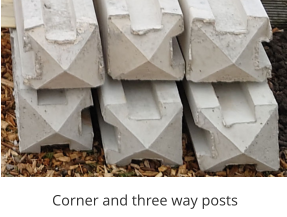
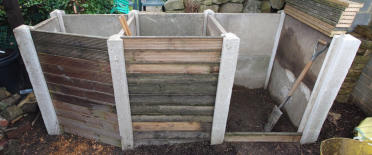
One
set
of
my
compost bins
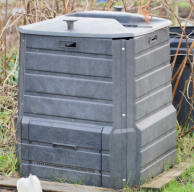
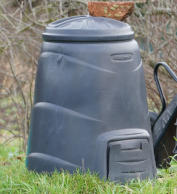
Wooden compost bins
Usually provided in a kit form, some are similar to my compost bins as in they have slotted posts (made of wood in this case) with slats that are slid down to create the sides. Others link together a bit like a jigsaw.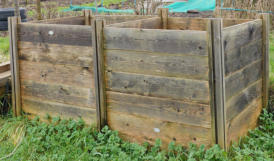
Hotbins
These are usually made of plastic and polystyrene combinations. They keep the heat in that is produced by the bacteria and they do not dry out so easily but do have a tap to allow you to collect the liquid to use as a liquid plant feed. From what I have read they have the advantage of being impenetrable to rodents allowing the composting of meats and cooked food waste which are items I would not usually add to a compost bin.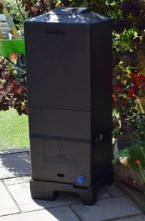
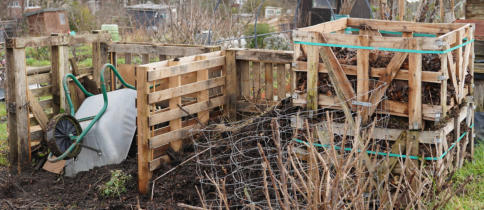


Email: graham@gardeningwithgraham.com
Terms and conditions
Follow on Instagram: gardening_with_graham_and_pam
© Graham Clark 2022

Compost bins
Composting has been around in one form or another for almost as long as people have grown food. Basically it is a process by which we combine our organic waste, such as from food preparation and garden clippings and then use the power of nature to convert these for use around the garden. There are many different types of compost bins available on the market but of course you can also easily construct your own, or if you have enough space just pile your composting material in a heap. Some of the compost bins available on the market claim to speed up the process of composting such as hot bins, these work by insulating the compost to keep the heat in and by trapping the moisture but I cannot vouch for these as I have never used one. Adding nitrates such as chicken manure or urine to any compost heap will also speed up the decomposing process.What options are there?
We shall start by looking at some of the compost bins that we can construct.Pallet compost bins
You see these regularly on allotments because they are cheap and easy to make. Pallets tend to be freely available if you can collect them, though some care has to be taken with which pallets you use. The wood that pallets are made from is treated in one form or another to preserve it. This could be just heat treatment or the use of strong preservative chemicals. Check out this site to find out which are safe earth911.com . Building a compost bin with pallets is straight forward, using four pallets ideally of equal size stand them on end in a square, fastening them together with wire (you can use screws or nails but wire is the simplest way). To improve the strength you can knock stakes down the cavity of the pallets into the ground. From an environmental point of view provided you use chemical fee pallets they are great because you are using natural materials that will break down though of course this is also there weak point because they need to be regularly replaced. Then of course what do you do with the rotten pallets? The large open gaps that you get from pallets give great access for wildlife making it an easy home for slow worms, snakes, mice or rats and they provide a good source of drainage meaning that the compost doesn’t get too wet. In my experience these gaps allow the contents to dry out too much but this can be improved by lining the insides with cardboard or wood. The other issue with these gaps is that they let the light in from the sides which makes it easy for weeds to grow through this will be improved by lining the insides but if you use cardboard this will soon start to break down and allow the perennial weeds to grow. This is a problem on allotments because many sites have problems with bindweed, putting this in any compost bin can be risky, but you must not put this in a pallet compost bin otherwise all that you will do is provide an ideal growing space for the bindweed to flourish.Bays
These usually are constructed on three sides with timber, though I have seen them build with concrete blocks and others with stone and usually don’t have a front. The size of these really depends on how much composting material you are likely to have and the available space. Often this is the method used on farms, large estates or parks and the composting material is turned using a tractor.Use your imagination
Knowing that principally a compost bin is just a way to contain the composting material during the decomposing process it easy to use your imagination to create something that will do the job. What you will need to consider, it must be fee draining and must be able to keep the contents moist. I have built my compost bins using 3ft x2ft concrete flags for three sides and wooden slats at the front, all held together using slotted concrete posts (corner posts and three ways posts). I have two like this at home and six on the allotment in banks if three for ease of compost turning. I fill the right most compost bin first then when full turn this into the bin next to it. When it needs turning again this is turned into the next bin. I always use the right most bin as the bin for fresh organic material. Below is a list of some commercially available options In my opinion commercial compost bins can be very expensive but weighing that up against the cost of buying compost and all the benefits from adding compost to your soil I do think they are a worthwhile investment if you cannot build your own. The plastic dalek shaped bins have been around for some time now and do work really well. These are often also available at subsidised prices from the local councils which make them an ideal budget option if cash is an issue. It is also worth keeping an eye on sites like Trash Nothing and Gumtree because used ones are often given away or offered for a small fee.Plastic compost bins
In some areas the local authority of these at a discount price to encourage you to compost your kitchen waste. These will last for years if looked after and are great if you only have small to medium amounts of composting materials such as kitchen waste and grass clippings. They have an open bottom and a lid that you remove to put your composting materials in, some have a front sliding panel which allows you to remove the compost from the bottom. The composting is relatively fast providing the contents are a good combination of materials (greens and browns). The compost at the bottom can be ready in as little as three months. I have used these for many years and produce some great compost for use as mulch around the garden, one compost bin was never enough for me, but then I compost as much as I can.
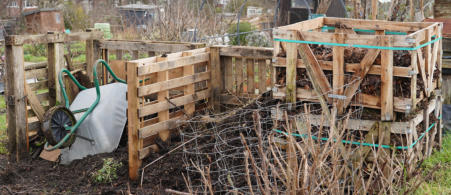
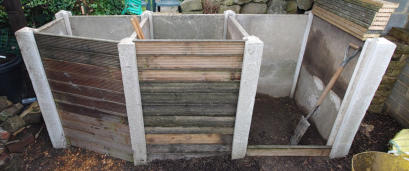
One set of my compost bins
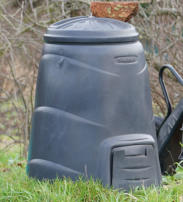

Hotbins
These are usually made of plastic and polystyrene combinations. They keep the heat in that is produced by the bacteria and they do not dry out so easily but do have a tap to allow you to collect the liquid to use as a liquid plant feed. From what I have read they have the advantage of being impenetrable to rodents allowing the composting of meats and cooked food waste which are items I would not usually add to a compost bin.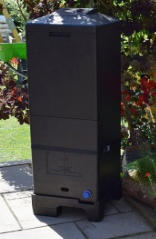
Wooden compost bins
Usually provided in a kit form, some are similar to my compost bins as in they have slotted posts (made of wood in this case) with slats that are slid down to create the sides. Others link together a bit like a jigsaw.
















